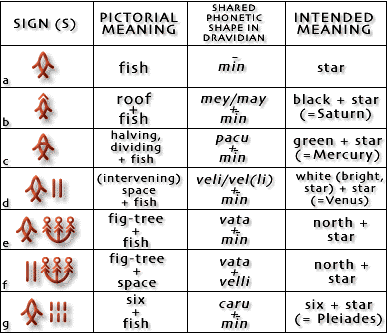
13. Systematic and interlocking interpretations of Harappan pictograms.
One further way to check the correctness of the above proposed interpretation of the 'fish' pictograms is to study Indus signs that occur next to the 'fish' pictograms. The task is to test whether any of these signs can be interpreted by applying the same methods and hypotheses, and to see if something reasonable emerges from the sign combinations. The Indus script is like a crossword puzzle: the individual sign interpretations are like the word guesses which have to fulfill certain strictly defined conditions and which are kept in control by examining how well they fit together.
A structural analysis of the Indus inscriptions shows that the 'fish' pictograms often form stable combinations with the immediately preceding signs. Moreover, many of the 'fish' signs themselves are combinations of the basic 'fish' pictogram and various diacritic marks, that is, differentiating or modifying additions. It is most likely that such compounded and diacritic signs in the Indus script have had the same function as in the readable pictographic writing systems of ancient Sumer and Egypt, where they have been used either to express words compounded with the basic sign or to clarify its meaning by quoting one of its homonyms or synonyms. Compounded words, of course, were meant to be read in addition to the basic sign, while phonetic or semantic complements just functioned as reading aids, helping to recognize the intended word, especially in ambiguous cases where the reader had a choice between several options. Now the question is, can these signs occurring next to the basic 'fish' sign be interpreted systematically and in such a way that they smoothly fit their context and the assumed reading of the 'fish' sign?
Unfortunately most of the Indus signs are so stylized and simplified that their original pictorial meaning cannot be recognized unambiguously. This means that normally the pictorial interpretations are bound to remain subjective and unreliable guesses. There are, however, some Indus signs whose pictorial meaning is beyond any reasonable doubt.
Among the diacritical marks added to the basic 'fish' sign is one that has been placed over the 'fish' sign and looks like a 'roof' (Fig. 13, b ). The most wide- spread root from which words denoting 'roof' are derived in the various Dravidian languages is *vay- : *vey- : *mey- 'to cover a house with a thatched roof', in which etymon the alternations *v- / *m- and *-ay- / *-ey- can be reconstructed for Proto-Dravidian 3. Thus in Proto-Dravidian the root *vey- / *mey- 'to roof' was partially homophonous with the root *may- 'black'. The sequence of the pictograms for 'roof' and 'fish' in the Indus script can be read in Proto-Dravidian as *mey-meen in the sense of *may-meen 'black star'. What makes this reading really significant is that the last-mentioned compound is factually attested as the name of the planet Saturn in the oldest available Dravidian texts, the poems of the Sangam literature written in Old Tamil in the early centuries of our era (Purananuru 117). Such a name is natural for Saturn, which is a dim planet, the root *may- (Tamil mai- ) meaning not only 'to be or become black' but also 'to be dim'.
The oldest Sanskrit texts dealing with the worship of the planets also associate Saturn with the colour black. They further mention Yama, the Hindu god of death, as the deity presiding over this dark planet. Yama is associated with the colour black in the Brahmana texts of the Veda (cf. e.g. Maitrayane Samhita 3,14,11 yamaya krsna). In classical Hinduism, Yama's colour is black and his vehicle usually the dark water buffalo. The planet Saturn, too, is said to ride the water buffalo in some texts.
But Saturn is not only a dark but also a slow planet; in fact, for this reason it is usually called sani or sanaiscara 'slowly-going' in Sanskrit. In the iconography of the Buddhists and the Jains, the planet Saturn rides the tortoise, whose slowness is proverbial. It seems quite likely to me that this association of the planet Saturn with the tortoise may go back to the Harappan times: the compounded Indus sign depicting a fish with a roof over it could, then, symbolize the deified planet Saturn even pictorially through his vehicle, for the tortoise is an aquatic animal (i.e. a kind of 'fish') covered with a shell (i.e. a kind of roof)!
[Originally published as Parpola, Asko (1988) Religion reflected in the iconic signs of the Indus script: penetrating into long-forgotten picto+graphic messages. Visible Religion 6: pp. 114-135.]
